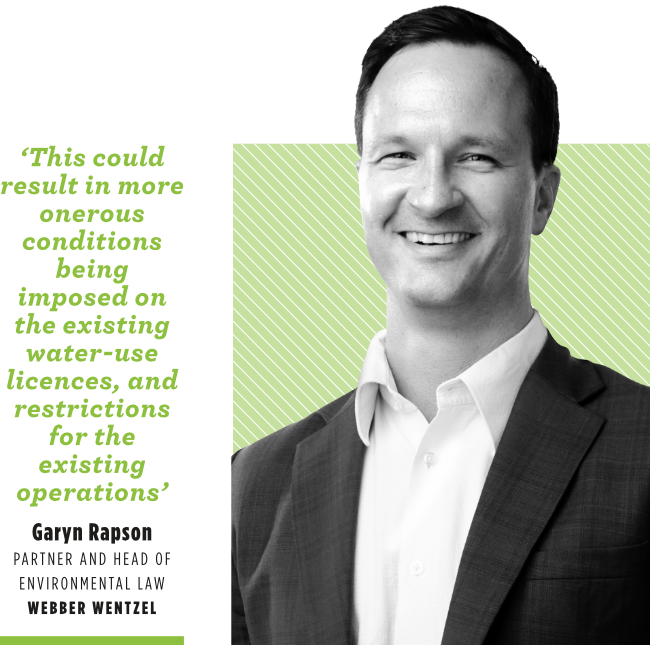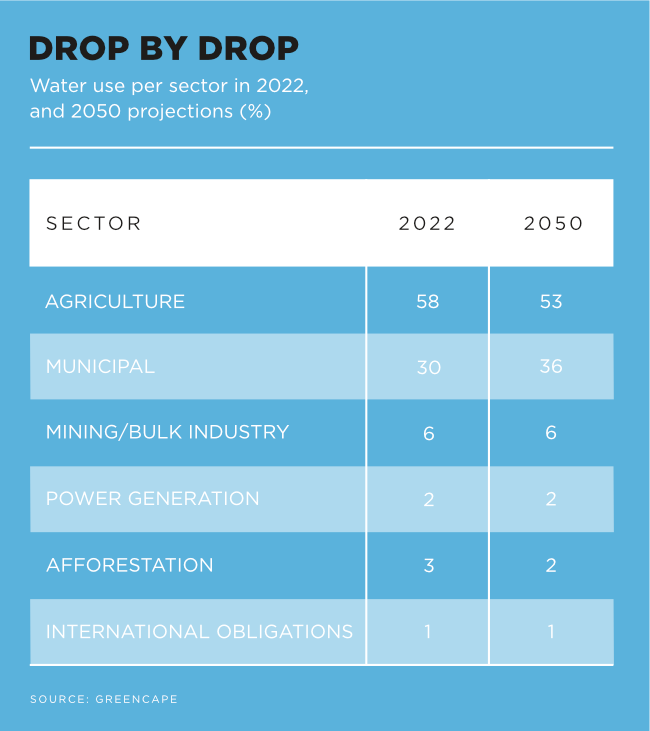The mining and agricultural sectors will be among those most affected by the enactment of recent environmental legislation and proposed changes to water laws.
Last year was notable for the enactment of most of the provisions of the long-awaited National Environmental Management Laws Amendment Act, aka NEMLAA 4, on 30 June 2023. Significantly, says Claire Tucker, head of the public law and regulatory practice at Bowmans, Section 24G of the National Environmental Management Act 107 of 1998 (NEMA), which falls under the umbrella of NEMLAA 4, has expanded the parameters for who can apply for ‘rectification’ of an unlawful listed activity. Previously, it was limited to the person who commenced the NEMA-listed activity without authorisation.
‘This has, historically, created some practical problems, such as when the premises at which the omission occurred has been sold and the historical transgressor is either no longer in existence or is unwilling to embark upon the Section 24G application in its own name,’ she says. ‘This problem can now be circumvented if one is “in control of, or a succession in title to, the land”.’
Tucker warns, however, that a decision to apply for rectification under Section 24G must be carefully considered as ‘the applicant may be directed to immediately cease the activity pending a decision on the application […] except if there are reasonable grounds to believe the cessation will result in serious harm to the environment’.
The applicant could also be slapped with an administrative fine of up to R10 million.
Carlyn Frittelli Davies, a consultant at ENS, outlines other amendments to NEMA, namely that variations on a waste-management licence will not be subject to a processing fee (Section 74); no exemptions will be allowed in terms of obtaining a waste-management licence (Section 79); and an owner of land that is likely to be (rather than significantly) contaminated, must notify the minister and MEC of such contamination as soon as they become aware of it.
Section 28 of NEMA, which deals with duty of care in the case of significant pollution or degradation of the environment, has also been amended under NEMLAA. It imposes an obligation on ‘every person who causes, has caused or may cause significant pollution or degradation of the environment, to take reasonable measures to prevent such pollution or degradation from occurring, continuing or recurring or, in so far as such harm to the environment is authorised by law or cannot be reasonably avoided or stopped, to minimise and rectify such pollution or degradation of the environment’.
NEMLAA has also extended the scope of who can issue directives under Section 28 of NEMA to include municipal managers instead of only directors-general and provincial heads of department.
Garyn Rapson, Webber Wentzel partner and head of environmental law, suggests this development will be a game-changer, ‘which may result in an environmental enforcement blitz, particularly at the municipal level’.
Bradley Thorpe, technical services specialist at waste and recycling management company Interwaste, believes there are pros and cons to this provision. ‘By giving authority to municipal managers to issue directives, it could assist in addressing potential environmental issues faster and more efficiently as they are on the ground and connected to their local operations,’ he says.
However, ‘the more people authorised to issue directives could also lead to a larger volume of directives being issued or the duplication of directives being issued, which would create a larger administrative burden on the relevant authority. The measure of success for this amendment will be how well it is communicated, implemented and managed across all relevant stakeholders.’
NEMLAA 4, however, is not entirely in force. Rapson points out that the Constitutional Court judgment in South African Iron and Steel Institute and Others v Speaker of the National Assembly and Others has knocked out some of the changes that NEMLAA 4 was expected to introduce. In this case, the court unanimously found that Parliament failed to comply in certain sections with its constitutional obligation to facilitate public involvement. The ruling affects the amended definition of ‘waste’, which would have excluded residue stockpiles and deposits. As such the definition remains unaltered, but residue stockpiles and deposits remain regulated under the National Environmental Management: Waste Act 59 of 2008 for now and the permitting requirements remain.
Changes to the role of the Waste Bureau have also suffered the knock-on effect.
‘Without a clear and concise definition of what is classified as “waste”, government and industry will be challenged to manage materials effectively, safely and compliantly. It could also have a negative impact on longer-term planning and investments for all parties,’ says Thorpe.
A draft amendment to the list of waste-management activities was published for comment on 9 February 2024, which will in essence mean that the establishment and operation of residual stockpiles and deposits will no longer require a waste-management licence. Instead, the regulation of residual stockpiles and deposits will be governed by NEMA when the relevant provisions and related listed activities are brought to force.
‘This change is long awaited and will allow easier management of these facilities for mining companies,’ says Frittelli Davies.
With many SA municipalities facing water-supply crises, water has become a hot-button issue. While water does not fall under NEMLAA, amendments to both the National Water Act of 1998 and the Water Services Act are in the offing.
‘This represents the first major change in approach in the sector since the National Water Act was enacted in 1998,’ according to Tucker.
Frittelli Davies says the National Water Act Amendment Bill, published in November 2023, could have significant implications ‘for companies operating in industries that rely heavily on water resources or have potential environmental impacts related to water usage’, such as mining, forestry and agriculture.
The bill includes a proposal to ban open-cast and underground mining operations that would lead to acid rock drainage in water-source areas, which means mining would in effect be banned from water-source areas as they would not be issued with water-use licences. Those ‘water-source areas’ will be identified by the Minister of Water and Sanitation.
In addition, Rapson says existing water-use licences in water-source areas for mining activities, forestry plantations and agricultural activities will be reviewed and new water-use licences may not be issued. ‘This could result in more onerous conditions being imposed on the existing water-use licences, and restrictions for the existing operations from having further water-use licences could stop future expansions from happening, which limits business growth.’
Thorpe says that while the proposal to ban open-cast mining in water-source areas ‘demonstrates a commitment to protect the quality of water […] it does not address the wider concerns related to water contamination such as agricultural runoff, industrial discharges or improper waste management practices. In order to protect our water supply and quality, a much more comprehensive and holistic approach is needed, including reviewing aspects such as monitoring, management and enforcement. Collaborative engagement with stakeholders and careful consideration of environmental impacts will be essential in striking a balance between environmental protection and socio-economic considerations’.
Tucker argues the provisions related to water-source areas ‘are not drafted in a particularly clear manner. In some instances, they are entirely peremptory, prohibiting certain practices outright. This is likely to cause rigidity in decision-making as authorities are not able to properly consider context in decision-making’.
Rapson says one clear intention of the amendment bill is to ‘redistribute water allocation in South Africa to provide more water to redress past discriminatory practices’.
The bill seeks to stop ‘holders of water-use licences for irrigation from transferring water-use licence – or portions thereof – to other persons. Transfers will only be allowed for the same owner, to land also owned by the owner and for no longer than 24 months. All trading in water in any form will be expressly prohibited. The latter proposed changes will directly impact the agricultural sector and the former will impact the mining sector’, he says.
Tucker highlights the impact the proposed legislation will have on farming, particularly. ‘The private trading in water allocations between neighbouring farms, surrender of an allocation in favour of a neighbouring property, and distribution of water allocations between properties to increase crop yields are frequently mechanisms for unlocking additional planting, crops and investment in agricultural areas.
‘The implication of the equitable access provisions is that applications for water allocations by privately owned family farms could be curtained. Overall, these changes could curtain agricultural investment and impact on South Africa’s agricultural exports,’ she says. ‘They could make South Africa a less attractive destination for foreign investment in this sector.’
The National Water Act Amendment Bill also has significant implications for company directors and municipal managers. Under Section 156A, directors of companies and municipal managers will automatically face charges under the National Water Act if they were acting in a representative capacity when the company or municipality committed an offence.
The bill also introduces strict liability – so not only could directors or municipal managers face personal legal consequences for offences committed under the National Water Act, they also would not be able to argue in their defence that reasonable measures were adopted.
Frittelli Davies says this may lead to ‘heightened regulatory scrutiny and accountability’ for businesses that depend on water resources. However, she notes that ‘the increased protection of water resources and scrutiny of water-use licence applications aligns with broader ESG goals, which is an increasingly important risk-management tool for businesses’.
According to Thorpe, ‘the efficacy of this bill depends on its implementation and management. It needs to balance accountability with promoting effective water-resource management’.
Rapson argues that the proposed director liability provision with strict liability ‘goes beyond the NEMA provisions, and it is undoubtedly unconstitutional. The proposed sentences for successfully prosecuted directors are also very steep’, he says.
Meanwhile, if manufacturers are not already aware of waste regulations governing the entire lifespan of their products, including post-consumer, they should be. In force since May 2021, regulations under Section 18 of the Waste Act make it mandatory for producers to register with the Department of Forestry, Fisheries and the Environment and ensure all identified products are covered by an appropriate extended producer responsibility (EPR) scheme.
Producers are legally obliged to join a producer responsibility organisation (PRO), form a new PRO or develop and submit an independent EPR scheme to the department. According to EPR regulations, PROs must work closely with packaging producers and brand owners to ensure that packaging is recycled post-consumer.
Fibre Circle, for example, was launched in 2019 to steer the paper and paper-packaging industry’s compliance to the then-upcoming EPR legislation. Close to 200 producers have already registered under Fibre Circle’s EPR programme, says CEO Edith Leeuta. ‘The fees paid to Fibre Circle will go a long way towards investing in infrastructure, awareness and behaviour change.
‘We have been working with the manufacturers and importers around solutions to drive the recovery of difficult-to-collect products and, through research and development, to improve the recycling capacity of difficult-to-recycle products, such as liquid board packaging [used beverage cartons], label backing paper and potato bags.’












